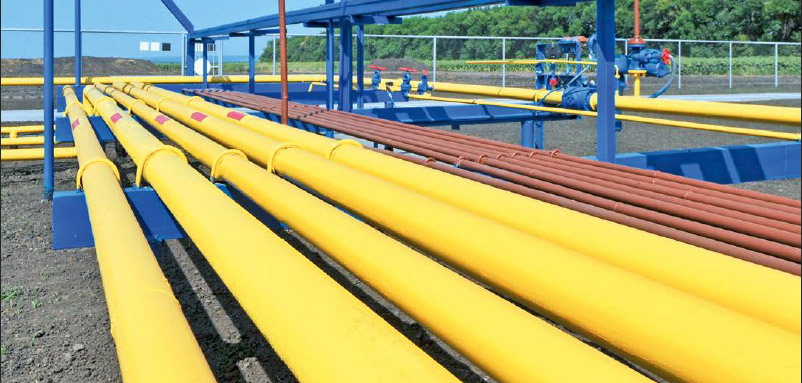Green technologies for producing energy are creating real hope: Bio-coal can already be produced synthetically through CO2 recycling, bio-butanol can be made with genetically- modified microbes and bio-gas and bio-hydrogen can be generated with wind power electrolysis. But it will take years for these technologies to be perfected and become profitable. Until then, natural gas can secure supply and help push forward the energy revolution in a practical manner by continuing to displace coal and oil. This could happen even faster for fuels with liquid natural gas (LNG), liquefied petroleum gas (LPG) and compressed natural gas (CNG). SICK process analytics and verifiable ultrasonic measurement technology are involved in production and distribution worldwide.

With about 12.5%, the EU is the third largest CO2 emitter in the world. With around 20% of the EU’s share, Germany has the largest share. About half of the EU’s emissions is created by the production of heat and power for residential buildings and industry, while a good 20% is created by road traffic. Both, particularly road traffic, use petroleum products on a large scale which is why a large share of gas is especially beneficial here, since natural gas burns with 25% less CO2.
Possible replacements are cryotechnically liquefied natural gas (LNG), natural gas liquids (LPG / liquid petroleum gas or camping gas) as well as compressed natural gas (CNG) which are heavily reduced in volume. All three ‒ in addition to hydrogen-powered fuel cells ‒ are major competitors for gasoline and diesel for goods transport. There is already a large filing station network for LPG; CNG is now being pushed by automobile manufacturers. Particularly promising, however, is LNG, which can be procured independent of pipelines and transported in large volumes by ship. It is particularly well-suited as a replacement for heavy fuel in maritime transport. It is also being discussed as a replacement for kerosene for powering airplanes. LNG can also independently supply industry and residential buildings, and even entire countries, like Japan. The EU also currently houses LNG port facilities with a fifth of the regasification capacity worldwide. The EU Commission is now also promoting massive LNG filling stations and trucks with liquefied natural gas tanks in the framework of the “LNG Blue Corridors” project.
Analytics for raw gas processing, liquefaction and emissions monitoring
SICK analytics are already used for the production of LNG and LPG. During raw gas processing, for example, a TRANSIC100LP laser spectrometer controls the supply of oxygen while the separated acid gas is burned to sulfur dioxide and processed into elementary sulfur. A GMS800 OXOR gas analyzer monitors the oxygen content in the Merox® process, in which LPG acquired from raw gas is desulfurized. The GMS800 UNOR makes a contribution to producing syngas for industrial application.
In a liquefaction plant in Oman, a GMS800 UNOR prevents residues from the previously separated CO2 from clogging the gas turbines of the cooling unit. On LNG tankers and floating evaporation platforms, MARSIC analyzer systems are used for continuous emission monitoring systems (CEMS); during evaporation on land, particularly cost-effective cold/dry extractive PowerCEMS50 systems perform the same task. In large LNG import projects in Panama and Bahrain, SICK is involved with complete measurement stations with which the quality and amount of the gases output to the customers are recorded reliably and with high accuracy. SICK also has the right analyzer systems for auxiliary plants for natural gas processing; CEMS monitor combustion processes in boilers and gas turbines while TRANSIC oxygen detectors measure the inert atmosphere in pipes and storage tanks. TOCOR analyzers show the smallest hydrocarbon contaminations in the process and cooling water, surface and waste water.
Accurate billing and intensified flare gas monitoring
The well-known, highly reliable and nearly maintenance-free ultrasonic flow measurement systems from SICK are also used all over the world. The FLOWSIC gas flow meters are used for recording gas volumes under the toughest conditions ‒ on drilling rigs in Norway, in coal gas fields in Australia and for shale drilling in the US, in flare gas and LNG systems as well as in the entire distribution network from the pipeline to the industrial end customer or CNG filling stations.
Flare gas alone is extremely climate-relevant: Around 350 million tons of CO2 are released all over the world every year through controlled or uncontrolled burning; this amounts to about 40% of all German CO2 emissions. In the meantime, verification requirements in many countries have started forcing drastic reductions and exact measurement of flare gas emissions. Many flares are therefore not in operation most of the time. The streamlined FLOWSIC100 Flare has proven its worth here; it can record the smallest flow rates, and can also withstand massive flows at short notice in the event of a malfunction.
Future vision of CO2-neutral fuels based on green energy
According to the Paris Agreement, 90% of energy should be created from renewable fuels by 2050. “Green” powerto- x processes could then be the focal point of a new gas infrastructure in which excessive green power is saved in the form of gas and converted to CO2-neutral fuels. Then synthetic natural gas and LNG could be created from wind power by means of power-to-gas. SICK is already testing the technology and developing suitable measurement concepts.
Related posts:
FLOWgate™: The gate to ultrasonic gas flow measuring devices from SICK
South african natural gas distributor counts on SICK flow meters
DOSIC - compact stainless-steel sensor for flexible flow measurement
